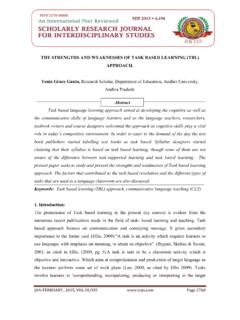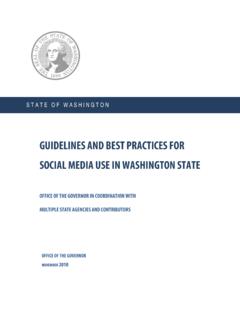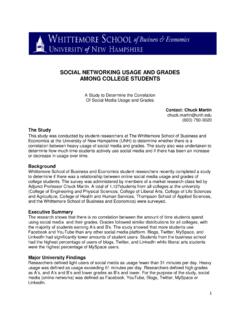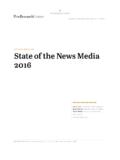Transcription of Gender Differences in Usage of Social Networking Sites and ...
1 The International Journal of Indian Psychology ISSN 2348-5396 (e) | ISSN: 2349-3429 (p). Volume 3, Issue 1, DIP: C00107V3I12015. | October December, 2015. Gender Differences in Usage of Social Networking Sites and Perceived Online Social Support on Psychological Well Being of Youth Nishi Misra1, Shivani Dangi1, Sanaya Patel 2. ABSTRACT. Social Networking Sites have been consuming a major part in the Youth daily routine. The study was conducted with an aim to study the effect of Social Networking Sites and perceived Social support on the psychological well-being of the youth. The sample size was 100 which had 50. males and 50 females.
2 All the participants were college going students or new entrants in the corporate sector. The participants were asked to fill the questionnaire which had four parts 1. Social Networking Sites Survey, 2. Multidimensional Scale of Perceived Social Support Assessment, 3. Psychological General Well-Being Index. The results indicated a negative relationship between the Usage of Social Networking Sites and the psychological well-being while positive relationship existed between online perceived Social support and psychological well- being. Certain Gender Differences were also found among the variables like perceived Social support and attraction towards Social Networking Sites .
3 This study has a lot of implications in terms of creating awareness among the youth so that they limit the Usage of Social Networking Sites and also a lot of research in the Indian context is yet to be done. Keywords: Social Networking Sites , Online Perceived Social support, Psychological well being Online Social Networking and Internet communication is becoming wildly popular with adolesc ents and young adults (Allen, Evans, Hare, Mikami, & Szwedo, 2010, AnderonButcher, Ball, Br zozowski, Lasseigne, Lehnert, & McCormick, 2010; DeGroot, Ledbetter, Mao, Mazer, Meyer, &. Swafford, 2011; Finkelhor, Mitchell, & Wolack, 2002; Greenfield & Subrahmanyam, 2008; Kra mer & Winter, 2008; Regan & Steeves, 2010; Sheldon, 2008).
4 According to the Nielsen Company, global consumers spent more than five and a half hours on Social Networking Sites like Face book and Twitter in December 2009, an 82% increase from the same time in the previous year when users were spending just over three hours on Social Networking Sites . 1. Defence Institute of Psychological Research, Defence R&D Organisation, Delhi, India 2. Deen Dayal Upadhyaya Petroleum University, Gandinagar, Delhi, India 2015 I N Misra, S Dangi, S Patel; licensee IJIP. This is an Open Access Research distributed under the terms of the Creative Commons Attribution License ( ), which permits unrestricted use, distribution, and reproduction in any Medium, provided the original work is properly cited.
5 Gender Differences in Usage of Social Networking Sites and Perceived Online Social Support on Psychological Well Being of Youth Social Networking Sites (SNSS): Social Networking phenomenon has emerged since the last 15-20 years. Since that time, SNS has grown from a niche to a mass online activity, in which millions of internet users are engaged, both in their leisure time and at workplace. Social Networking is a phenomenon that existed ever since society was formed. Human beings always sought to live in Social environments. The proliferation of SNS and their pervasion in everyday life is now affecting how the youth (Gen Y). round the globe especially in India are managing their network.
6 The willingness of users to consider SNS as a means of communication and Social Networking in everyday life has made it compulsory for the authorities to frame new policies. Online Social Networking Sites like Face book, LinkedIn, Instagram, and Google Buzz are influencing the way users establish, maintain and cultivate a range of Social relationships from close friendships to casual acquaintances. These Social Networking Sites (SNS) are nothing but websites which make it possible to form online communities and share user created content . There have been several definitions of the term Social Networking which has lead to confusion among readers.
7 For this, SNS can be broadly defined as internet-based Social spaces designed to facilitate communication, collaboration and content sharing across networks of contacts. It allows members to manage, build and represent their Social networks online. SNSs are utilized by people of all the age groups but the adolescents and youth use it to the fullest for various purposes (mainly communication). The Internet as a medium of research has changed drastically since it has become more complex, virtual, Social and physical such that the youth participates and co-constructs something, rather than just simply watching on the television or personal computers.
8 It is a complex virtual world behind that small screen on which developmental issues play out. (Deshmukh al., 2014) Online mediums also connect people in a person-to-person manner which is more direct and interpersonal. The levels of verbal and affective intimacy can be known through observing the frequency of posts on popular SNSs.(Kross et al., 2013) The popularity of Social Networking Sites is not just based on how many people it has but on how many hours or time a user spends on it daily. Some Social aspects like family pattern, age, communication among the members play a vital role in the youth's web Usage . Adequate parenting plays the role of a catalyst in serving the Social and emotional needs of the youth, devoid of such parenting they result in fulfilling those needs from online Sites .
9 Social media Usage behaviour is developing and transforming at a rapid rate leaving its affects on the youth. (Lee, Lee, Kwon, 2011)The dark side of Social Medias that its excessive Usage effects all the facets of a youth's life including psychological, emotional, physical well-being and Social development. Gender Differences are apparent in Social Networking Sites preferences and amount of use. The Sites most popular with teenagers and young adults of both genders (as of 2014) are Facebook and Twitter, which constitute Social network Sites according to the three criteria articulated by Pempek (2009). They have user profiles, allow for friending' (or following' on Twitter), and contain Social networks that can be navigated to encounter friends of friends.
10 A few study The International Journal of Indian Psychology | 64. Gender Differences in Usage of Social Networking Sites and Perceived Online Social Support on Psychological Well Being of Youth conducted in the found that 80% of online teens use Social network Sites , Facebook being the most popular, with 93% of those teens reporting its use (Mango et al., 2008) However, girls on average spend more time on Social network Sites and use them more actively than boys do (Burke,2010). More girls than boys use Facebook and Twitter; female users, including teens, also predominate on the online pinboard Pinterest. Conversely, more males use music-sharing Sites such as , as well as Reddit, a Social news website known for its sometimes misogynistic content (Kraut & Crawford, 2012).



















